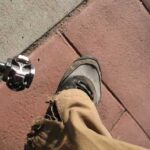If you’ve seen a serious biker in their element, you might have noticed use of clipless pedals. These nifty accessories can give a potent advantage to cyclists who want more power, control, and stability.
Despite this, however, there are many circumstances that cause even the most experienced biker to revert to old-fashioned flat pedals. But why? In order to answer this question; let’s start at the beginning and explain what are clipless pedals and how do they work.
We’ll then go over their advantages and explain why it’s sometimes a good idea to forgo your fancy shoes and stick to the tried and true flat pedal for your trail day.
What Are Clipless Pedals and How Do They Work?
Clipless pedals are pedals that feature small clips that interlock with a cleat on a pair of matching shoes.
The term “clipless” here is a bit of a misnomer. Instead of denoting the lack of a clip on the pedal, it differentiates these pedals with an older style of pedal called “toe clips.”
The toe-clip style of pedal features large plastic clips that wrap around a standard shoe. Clipless pedals (sometimes called ‘clips) lack this massive structure. Instead, they’re light and smaller than some flat pedals.
The functionality of a clipless pedal is quite similar to a ski binding. The pedal features a hard surface that’s designed to capture a special cleat built into your cycling shoes.
Riders insert the shoes and twist, locking the shoes and pedals together. While the shoes are locked in, the cyclist can pull pedals upwards in addition to pushing them down, allowing for more power and control.
When the ride is over, the rider twists their feet again (heels out) to release their shoes.


Benefits of Using Clipless Pedals
If you’re just biking in a straight line, clips have a simple benefit: you get more power. Because you can get power from your legs going up as well as down, these pedals enable you to utilize more muscles and go faster.
Additionally, you preserve any energy you would have wasted from accidental foot shifts and twists as you ride.
Clips really shine in mountain biking when it comes to fine control and maneuvering over obstacles. Hopping with your shoes attached to the pedals is basically cheating.
Your feet can pull up on the bicycle and adjust its positioning both up and down. Even if you’re not doing full bunnyhops, clips give you much more control when you’re popping a wheel over a log, curb, or another obstacle.
Perhaps most importantly, clipless pedals ensure that your feet make full contact with the pedals, no matter how bumpy the terrain is.
When you’re going straight on a flat surface, you don’t lose too much power from your feet shifting around.
When you’re riding on rocks, however, the bike bumps all over the place. Clips keep your feet glued to the pedals the whole time, giving you both control and speed.
Recommended Product: Funn Mamba S Mountain Bike Clipless Pedal Set ( Amazon Link )
Setting up Clipless Pedals is Most Important!
If you’re using clipless pedals for the first time, don’t forget to set them up properly! Most shoes and pedals are quite adjustable, giving you lots of options for where the cleat sits on the shoes, how far out the pedals are, and even what type of pedals are used.
Adjusting all of these variables can be daunting for newcomers, so here’s a quick tip on where to start.
When it comes to placing the clip on your shoe, think about where your feet naturally rest when you use flat pedals. Start with the clips on the balls of your feet and adjust from there.
Moving the clips forwards (towards the toes) will angle your toes down while you ride while moving the clips back will help keep your feet level. There’s not a big advantage to either style, so go with the one you prefer.
As far as clip orientation goes, consider the act of clipping out. Some mountain bike riders actually prefer to angle their clips opposite to the way that their pedals clip out. They then ride with their feet straight.
Because of the angled clips, these riders can clip out much faster when they want to bail. Consider your own preferences and experience when choosing how to orient your clips.
If you don’t have a strong preference, perfectly straight is probably the way to go.
Be Sure to Tighten Them Securely
Finally, make sure that your pedals clip onto your shoes properly. If there’s a lot of shoe rubber interfering with the process, look for a spacer that you can put in between your clips and your shoes.
This will help make it easier to clip and unclip without making a big fuss.
Once you’ve got your clips set up, be sure to tighten them securely. If a clip becomes unscrewed while you ride, it’ll tend to get tangled hopelessly with the pedal, leading to an embarrassing fall when you go to dismount.
As far as the pedals go, be sure that you’ve got enough clearance between your feet and your bike while you ride, clip, and unclip. If your toes touch the chain of your bicycle during the act of clipping in or out, you might want to adjust your pedals to be farther from the bike.
In terms of pedal style, there’s no real right or wrong answer. Go with something that suits you.
In general, big pedals are best for soft shoes and rides where you might not be clipped in at all times, while smaller pedals go great with hard riding shoes and trails where you’re always clipped in.
Benefits of Using Flat Pedals
The biggest downside of clipless pedals is the rider’s inability to remove their foot from the pedal. It’s not terribly difficult to learn how to unclip your shoes from the pedals.
You just give them a little twist – but it’s an entirely different story when it comes to disconnecting your feet right before you crash. Even experienced cyclists can fail to unclip properly during a routine, boring stop.
Flats, by contrast, offer increased safety, fun, and comfort. They’re also a better learning tool for most sorts of technical riding and they tend to be cheaper than a comparable set of clips.
When your bike has lost traction and you’re tumbling down a hill, it can be quite hard to perform the proper set of actions in the right order.
Flats, by contrast, do not share this problem. In fact, flats practically beg for you to have your feet out and ready to hit the dirt when you’re skidding around corners and messing about in the mud.
You won’t get into fewer crashes due to having flats ( in fact, some could argue that added control from clips can help avoid crashes), but you certainly won’t have any problems due to being unable to bail.
Many serious cyclists enjoy having a bike set up with flats for the sheer fun factor. It’s not that biking with clips is less fun, but rather that it’s less committal. With clips, you have to put on a special set of shoes.
Each time you start or stop, you have to engage in a little ritual to marry your shoes to the bicycle. This makes it harder to just jump on a bike and mess around.
Flat pedals are usually what people learn to ride on, so for many riders, they’re a bit more comfortable.
Recommended Product: ROCKBROS Mountain Bike Lightweight Flat Pedals ( Amazon Link )
To Clip or Not To Clip? Mountain Biking
In mountain biking, clipping into your pedals can provide a big advantage. As long as you’re in control, being clipped in allows you to keep your footing in even the roughest terrain, and can change the way you pedal.
That said, there are plenty of reasons why you might want to leave your clips at home.
The first reason is cost. Clipless pedals aren’t super pricey, but their shoes usually are specific to one manufacturer of pedals, it can be expensive to switch to a new brand of clips for the first time.
If you’re not looking to spend money on your bike, stick with flats. You’ll be fine.
The second reason has to do with the types of trails you’re riding on. If you think you might have to bail often, consider using flats especially at the beginning.
Skilled riders can definitely unclip safely and bail from hairy situations without issues – sometimes.
By using flats, you can eliminate a variable that might end up getting you injured. If you’ve got a feeling you’re going to bail a lot, it’s a good idea to preemptively switch to flats.
Finally, consider who you’re biking with. If someone else is going to use your bike, do they have shoes for your pedals? If they don’t, you’ll definitely want to put the flats on for this excursion.
In most other circumstances, clips offer a tangible edge over flats for most types of mountain biking.
If you’re planning on encountering technical terrain, rough slopes, or even just long stretches of flat ground to ride on, clips will keep your feet on the pedals and give you a bit of an advantage.
If you’re biking for fun, however, don’t stress out too much about this advantage. Use the pedals you prefer.
Are Clipless Pedals More Efficient?
When it comes to mountain biking, clipless pedals are much more efficient than flat pedals.
Several studies have been done by reputable scientists on the difference between clips, toeclips, and flats. Unfortunately, these studies were conducted on stationary bicycles.
While their conclusions might have been that there’s no real difference in power or efficiency between the pedal types, this conclusion is essentially meaningless in the world of mountain biking.
The reason for this is simple: stationary bikes are stationary. Mountain bikes hop all over the place. When you’re clipped in, your feet stay glued to the pedals at all times.
This means that you never have to readjust them, you never lose power due to your foot being in an unexpected place, and you almost never hit yourself in the shin with a pedal.
With flats, by contrast, your feet slip around all over the place. Bumps, jumps, and even hills can cause your feet to slide around or hop off the pedals, making it impossible for you to operate at full efficiency.
This isn’t to say that you’ll go faster with clips. In fact, some cyclists go faster on some sections with flats because they feel more confident in their ability to bail.
At the end of the day, the pedal system that you’re most comfortable with will probably be the best one for you. If you’re looking for efficiency, however, clipless pedals are definitely the better choice for non-stationary bicycles.
Flat vs Clipless Pedals: Which One Wins?
By keeping your feet on your bike at all times, clipless pedals give mountain bikers more control, efficiency, and power. They’re lighter than traditional flat pedals, come with special cycling shoes, and are virtually required in most competitions where they’re allowed.
By contrast, flats are less expensive, more fun, and make it much easier to bail.
For anyone on a budget, anyone learning to mountain bike, or someone who’s braving a particularly treacherous trail, flats are likely the superior choice.
As mentioned above, however, the advantages and disadvantages of each system shouldn’t outweigh your personal preference. If you prefer clips or flats, use that particular style of pedal! Cycling should be fun.
Don’t let your pedal preference get in the way of going out, hitting a trail, and having a good time.
Also Read,
15 Best Mountain Bike Brand in 2022 – Bicycle Guide
Can You Use Clipless Pedals With Normal Shoes?









Leave a Reply